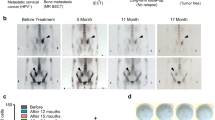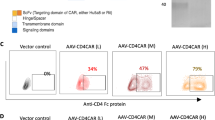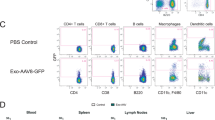Abstract
Adoptively transferred T cells possess anticancer activities partially mediated by T-cell FasL engagement of Fas tumor targets. However, antigen-induced T-cell activation and clonal expansion, which stimulates FasL activity, is often inefficient in tumors. As a gene therapy approach to overcome this obstacle, we have created oncoretroviral vectors to overexpress FasL or non-cleavable FasL (ncFasL) on murine T cells of a diverse T-cell receptor repertoire. Expression of c-FLIP was also engineered to prevent apoptosis of transduced cells. Retroviral transduction of murine T lymphocytes has historically been problematic, and we describe optimized T-cell transduction protocols involving CD3/CD28 co-stimulation of T cells, transduction on ice using concentrated oncoretrovirus, and culture with IL-15. Genetically modified T cells home to established prostate cancer tumors in vivo. Co-stimulated T cells expressing FasL, ncFasL and ncFasL/c-FLIP each mediated cytotoxicity in vitro against RM-1 and LNCaP prostate cancer cells. To evaluate the compatibility of this approach with current prostate cancer therapies, we exposed RM-1, LNCaP, and TRAMP-C1 cells to radiation, mitoxantrone, or docetaxel. Fas and H-2b expression were upregulated by these methods. We have developed a novel FasL-based immuno-gene therapy for prostate cancer that warrants further investigation given the apparent constitutive and inducible Fas pathway expression in this malignancy.
This is a preview of subscription content, access via your institution
Access options
Subscribe to this journal
Receive 12 print issues and online access
$259.00 per year
only $21.58 per issue
Buy this article
- Purchase on Springer Link
- Instant access to full article PDF
Prices may be subject to local taxes which are calculated during checkout







Similar content being viewed by others
References
Morgan RA, Dudley ME, Wunderlich JR, Hughes MS, Yang JC, Sherry RM et al. Cancer regression in patients after transfer of genetically engineered lymphocytes. Science 2006; 314: 126–129.
Rosenberg SA, Dudley ME . Cancer regression in patients with metastatic melanoma after the transfer of autologous antitumor lymphocytes. Proc Natl Acad Sci USA 2004; 101: 14639–14645.
Gade TPF, Hassen W, Santos E, Gunset G, Saudemont A, Gong MC et al. Targeted elimination of prostate cancer by genetically directed human T lymphocytes. Cancer Res 2005; 65: 9080–9088.
Kershaw MH, Teng MW, Smyth MJ, Darcy PK . Supernatural T cells: genetic modification of T cells for cancer therapy. Nat Rev Immunol 2005; 5: 928–940.
Lu B, Finn OJ . T-cell death and cancer immune tolerance. Cell Death Differ 2008; 15: 70–79.
Kessler B, Hudrisier D, Schroeter M, Tschopp J, Cerottini JC, Luescher IF . Peptide modification or blocking of CD8, resulting in weak TCR signaling, can activate CTL for Fas- but not perforin-dependent cytotoxicity or cytokine production. J Immunol 1998; 161: 6939–6946.
Dobrzanski MJ, Reome JB, Hollenbaugh JA, Hylind JC, Dutton RW . Effector cell-derived lymphotoxin α and Fas ligand, but not perforin, promote Tc1 and Tc2 effector cell-mediated tumor therapy in established pulmonary metastases. Cancer Res 2004; 64: 406–414.
Frost P, Caliliw R, Belldegrun A, Bonavida B . Immunosensitization of resistant human tumor cells to cytotoxicity by tumor infiltrating lymphocytes. Int J Oncol 2003; 22: 431–437.
Schulte M, Reiss K, Lettau M, Maretzky T, Ludwig A, Hartmann D et al. ADAM10 regulates FasL cell surface expression and modulates FasL-induced cytotoxicity and activation-induced cell death. Cell Death Differ 2007; 14: 1040–1049.
Shimizu M, Takeda Y, Yagita H, Yoshimoto T, Matsuzawa A . Antitumor activity exhibited by Fas ligand (CD95L) overexpressed on lymphoid cells against Fas+ tumor cells. Cancer Immunol Immunother 1998; 47: 143–148.
Li X, Liu YH, Zhang YP, Zhang S, Pu X, Gardner TA et al. Fas ligand delivery by a prostate-restricted replicative adenovirus enhances safety and antitumor efficacy. Clin Cancer Res 2007; 13: 5463–5473.
Symes JC, Kurin M, Fleshner NE, Medin JA . Fas-mediated killing of primary prostate cancer cells is increased by mitoxantrone and docetaxel. Mol Cancer Ther 2008; 7: 3018–3028.
Tanaka M, Suda T, Yatomi T, Nakamura N, Nagata S . Lethal effect of recombinant human Fas ligand in mice pretreated with Propionibacterium acnes. J Immunol 1997; 158: 2303–2309.
Aoki K, Akyurek LM, San H, Leung K, Parmacek MS, Nabel EG et al. Restricted expression of an adenoviral vector encoding Fas ligand (CD95L) enhances safety for cancer gene therapy. Mol Ther 2000; 1: 555–565.
Mezzanzanica D, Balladore E, Turatti F, Luison E, Alberti P, Bagnoli M et al. CD95-mediated apoptosis is impaired at receptor level by cellular FLICE-inhibitory protein (long form) in wild-type p53 human ovarian carcinoma. Clin Cancer Res 2004; 10: 5202–5214.
Van Parijs L, Refaeli Y, Abbas AK, Baltimore D . Autoimmunity as a consequence of retrovirus-mediated expression of C-FLIP in lymphocytes. Immunity 1999; 11: 763–770.
Hagani AB, Riviere I, Tan C, Krause A, Sadelain M . Activation conditions determine susceptibility of murine primary T-lymphocytes to retroviral infection. J Gene Med 1999; 1: 341–351.
Pouw NM, Westerlaken EJ, Willemsen RA, Debets R . Gene transfer of human TCR in primary murine T cells is improved by pseudo-typing with amphotropic and ecotropic envelopes. J Gene Med 2007; 9: 561–570.
Zhang T, Tsang TC, Harris DT . Efficient transduction of murine primary T cells requires a combination of high viral titer, preferred tropism, and proper timing of transduction. J Hematother Stem Cell Res 2003; 12: 123–130.
Annenkov AE, Daly GM, Chernajovsky Y . Highly efficient gene transfer into antigen-specific primary mouse lymphocytes with replication-deficient retrovirus expressing the 10A1 envelope protein. J Gene Med 2002; 4: 133–140.
Sheard MA, Uldrijan S, Vojtesek B . Role of p53 in regulating constitutive and X-radiation-inducible CD95 expression and function in carcinoma cells. Cancer Res 2003; 63: 7176–7184.
Bagnoli M, Balladore E, Luison E, Alberti P, Raspagliesi F, Marcomini B et al. Sensitization of p53-mutated epithelial ovarian cancer to CD95-mediated apoptosis is synergistically induced by cisplatin pretreatment. Mol Cancer Ther 2007; 6: 762–772.
Chatterjee D, Schmitz I, Krueger A, Yeung K, Kirchhoff S, Krammer PH et al. Induction of apoptosis in 9-nitrocamptothecin-treated DU145 human prostate carcinoma cells correlates with de novo synthesis of CD95 and CD95 ligand and down-regulation of c-FLIP(short). Cancer Res 2001; 61: 7148–7154.
Liu QY, Rubin MA, Omene C, Lederman S, Stein CA . Fas ligand is constitutively secreted by prostate cancer cells in vitro. Clin Cancer Res 1998; 4: 1803–1811.
Muller M, Wilder S, Bannasch D, Israeli D, Lehlbach K, Li-Weber M et al. p53 activates the CD95 (APO-1/Fas) gene in response to DNA damage by anticancer drugs. J Exp Med 1998; 188: 2033–2045.
Romano C, De Fanis U, Sellitto A, Chiuraxxi F, Guastafierro S, Giunta R et al. Induction of CD95 upregulation does not render chronic lymphocytic leukemia B-cells susceptible to CD95-mediated apoptosis. Immunol Lett 2005; 97: 131–139.
Liang SB, Yoshimitsu M, Poeppl A, Rasaiah VI, Cai J, Fowler DH et al. Multiple reduced-intensity conditioning regimens facilitate correction of Fabry mice after transplantation of transduced cells. Mol Ther 2007; 15: 618–627.
Jung U, Foley JE, Erdmann AA, Eckhaus MA, Fowler DH . CD3/CD28-costimulated T1 and T2 subsets: differential in vivo allosensitization generates distinct GVT and GVHD effects. Blood 2003; 102: 3439–3446.
Takenaka T, Qin G, Brady RO, Medin JA . Circulating alpha-galactosidase A derived from transduced bone marrow cells: relevance for corrective gene transfer for Fabry disease. Hum Gene Ther 1999; 10: 1931–1939.
Markowitz D, Goff S, Bank A . A safe packaging line for gene transfer: separating viral genes on two different plasmids. J Virol 1988; 62: 1120–1124.
Niederman TM, Ghogawala Z, Carter BS, Tompkins HS, Russell MM, Mulligan RC . Antitumor activity of cytotoxic T lymphocytes engineered to target vascular endothelial growth factor receptors. Proc Natl Acad Sci USA 2002; 99: 7009–7014.
Rouvier E, Luciani MF, Golstein P . Fas involvement in Ca(2+)-independent T cell-mediated cytotoxicity. J Exp Med 1993; 177: 195–200.
Takahashi T, Tanaka M, Inazawa J, Abe T, Suda T, Nagata S . Human Fas ligand: gene structure, chromosomal location and species specificity. Int Immunol 1994; 6: 1567–1574.
Bunnell BA, Muul LM, Donahue RE, Blaese RM, Morgan RA . High-efficiency retroviral-mediated gene transfer into human and nonhuman primate peripheral blood lymphocytes. Proc Natl Acad Sci USA 1995; 92: 7739–7743.
Darcy PK, Haynes NM, Snook MB, Trapani JA, Cerruti L, Jane SM et al. Redirected perforin-dependent lysis of colon carcinoma by ex vivo genetically engineered CTL. J Immunol 2000; 164: 3705–3712.
Turka LA, Walsh PT . IL-2 signaling and CD4+ CD25+ Foxp3+ regulatory T cells. Front Biosci 2008; 13: 1440–1446.
Pollok KE, van der Loo JC, Cooper RJ, Kennedy L, Williams DA . Costimulation of transduced T lymphocytes via T cell receptor-CD3 complex and CD28 leads to increased transcription of integrated retrovirus. Hum Gene Ther 1999; 10: 2221–2236.
Quinn ER, Lum LG, Trevor KT . T cell activation modulates retrovirus-mediated gene expression. Hum Gene Ther 1998; 9: 1457–1467.
Wallace DL, Berard M, Soares MV, Oldham J, Cook JE, Akbar AN et al. Prolonged exposure of naive CD8+ T cells to interleukin-7 or interleukin-15 stimulates proliferation without differentiation or loss of telomere length. Immunology 2006; 119: 243–253.
Berard M, Brandt K, Bulfone-Paus S, Tough DF . IL-15 promotes the survival of naive and memory phenotype CD8+ T cells. J Immunol 2003; 170: 5018–5026.
Klebanoff CA, Finkelstein SE, Surman DR, Lichtman MK, Gattinoni L, Theoret MR et al. IL-15 enhances the in vivo antitumor activity of tumor-reactive CD8+ T cells. Proc Natl Acad Sci USA 2004; 101: 1969–1974.
Algarra I, Garcia-Lora A, Cabrera T, Ruiz-Cabello F, Garrido F . The selection of tumor variants with altered expression of classical and nonclassical MHC class I molecules: implications for tumor immune escape. Cancer Immunol Immunother 2004; 53: 904–910.
Bander NH, Yao D, Liu H, Chen YT, Steiner M, Zuccaro W et al. MHC class I and II expression in prostate carcinoma and modulation by interferon-alpha and -gamma. Prostate 1997; 33: 233–239.
Ohtsukasa S, Okabe S, Yamashita H, Iwai T, Sugihara K . Increased expression of CEA and MHC class I in colorectal cancer cell lines exposed to chemotherapy drugs. J Cancer Res Clin Oncol 2003; 129: 719–726.
Watermann I, Gerspach J, Lehne M, Seufert J, Schneider B, Pfizenmaier K et al. Activation of CD95L fusion protein prodrugs by tumor-associated proteases. Cell Death Differ 2007; 14: 765–774.
Herrmann T, Grosse-Hovest L, Otz T, Krammer PH, Rammensee HG, Jung G . Construction of optimized bispecific antibodies for selective activation of the death receptor CD95. Cancer Res 2008; 68: 1221–1227.
Westwood JA, Murray WK, Trivett M, Shin A, Neeson P, MacGregor DP et al. Absence of retroviral vector-mediated transformation of gene-modified T cells after long-term engraftment in mice. Gene Therapy 2008; 15: 1056–1066.
Selleck WA, Canfield SE, Hassen WA, Meseck M, Kuzmin AI, Eisensmith RC et al. IFN-gamma sensitization of prostate cancer cells to Fas-mediated death: a gene therapy approach. Mol Ther 2003; 7: 185–192.
Owen-Shaub L, Radinsky R, Kruzel E, Berry K, Yonehara S . Anti-Fas on nonhematopoietic tumors: levels of Fas/APO-1 and bcl-2 are not predictive of biological responsiveness. Cancer Res 1994; 54: 1580–1586.
Baley PA, Yoshida K, Qian W, Sehgal I, Thompson TC . Progression to androgen insensitivity in a novel in vitro mouse model for prostate cancer. J Steroid Biochem Mol Biol 1995; 52: 403–413.
Fenton RG, Hixon JA, Wright PW, Brooks AD, Sayers TJ . Inhibition of Fas (CD95) expression and Fas-mediated apoptosis by oncogenic Ras. Cancer Res 1998; 58: 3391–3400.
Suzuki I, Fink PJ . Maximal proliferation of cytotoxic T lymphocytes requires reverse signaling through Fas ligand. J Exp Med 1998; 187: 123–128.
Sun M, Ames KT, Suzuki I, Fink PJ . The cytoplasmic domain of Fas ligand costimulates TCR signals. J Immunol 2006; 177: 1481–1491.
Abad JD, Wrzensinski C, Overwijk W, De Witte MA, Jorritsma A, Hsu C et al. T-cell receptor gene therapy of established tumors in a murine melanoma model. J Immunother 2008; 31: 1–6.
Dohrman A, Russell JQ, Cuenin S, Fortner K, Tschopp J, Budd RC . Cellular FLIP long form augments caspase activity and death of T cells through heterodimerization with and activation of caspase-8. J Immunol 2005; 175: 311–318.
Krueger A, Schmitz I, Baumann S, Krammer PH, Kirchhoff S . Cellular FLICE-inhibitory protein splice variants inhibit different steps of caspase-8 activation at the CD95 death-inducing signaling complex. J Biol Chem 2001; 276: 20633–20640.
Smith KG, Strasser A, Vaux DL . CrmA expression in T lymphocytes of transgenic mice inhibits CD95 (Fas/APO-1)-transduced apoptosis, but does not cause lymphadenopathy or autoimmune disease. EMBO J 1996; 15: 5167–5176.
Dotti G, Savoldo B, Pule M, Straathof KC, Biagi E, Yvon E et al. Human cytotoxic T lymphocytes with reduced sensitivity to Fas-induced apoptosis. Blood 2005; 105: 4677–4684.
Medin J, Liang S-B, Hou J, Kelley LS, Peace DJ, Fowler DH . Efficient transfer of PSA and PSMA cDNAs into DCs generates antibody and T cell antitumor responses in vivo. Cancer Gene Ther 2005; 12: 540–551.
Acknowledgements
We thank Anton Neschadim and Dr Richard Miller for helpful discussions about transductions and T-cell biology. This work is supported by a grant from the Prostate Cancer Research Foundation of Canada.
Author information
Authors and Affiliations
Corresponding author
Rights and permissions
About this article
Cite this article
Symes, J., Siatskas, C., Fowler, D. et al. Retrovirally transduced murine T lymphocytes expressing FasL mediate effective killing of prostate cancer cells. Cancer Gene Ther 16, 439–452 (2009). https://doi.org/10.1038/cgt.2008.96
Received:
Revised:
Accepted:
Published:
Issue Date:
DOI: https://doi.org/10.1038/cgt.2008.96



